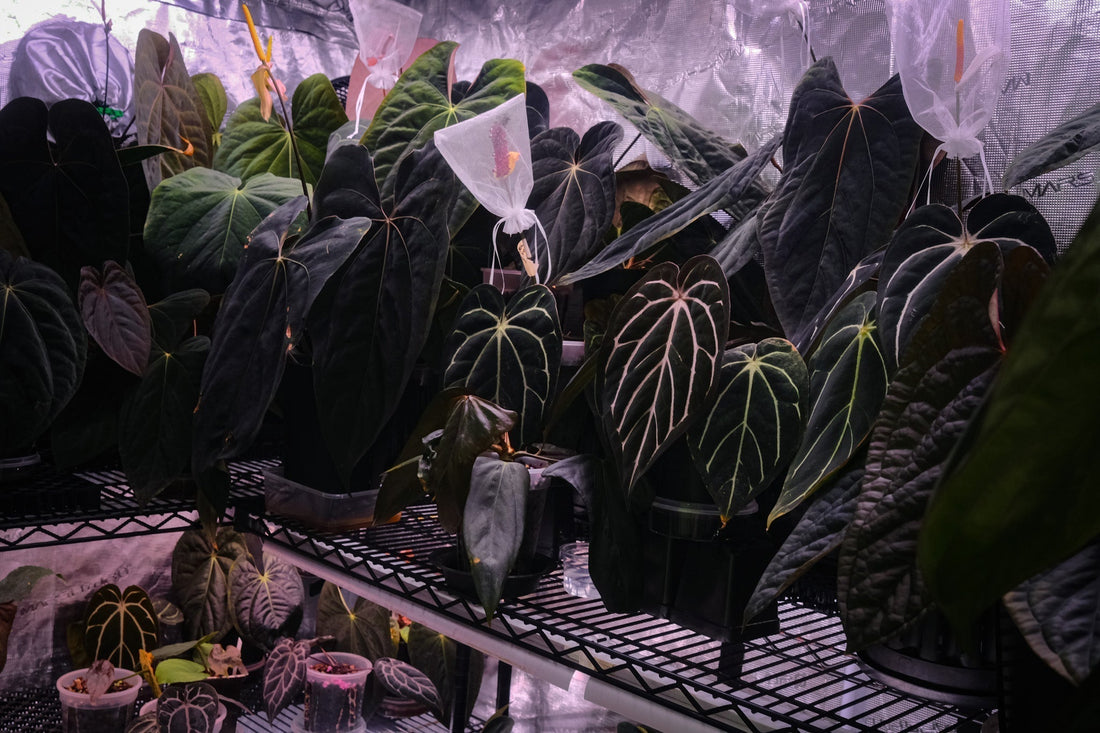
Watering and Fertilizing
Share
Following the previous article on lighting conditions, I’d like to share more about our watering schedule and fertilizing regime at OurPlantStory.
If you’ve been following our previous founder, Eric, or me (@pieroroots) for a while, you would know we love to leave a layer of water in our trays. This allows the media to stay consistently moist with the right mix without introducing a wet/dry cycle, which we find detrimental to most Anthuriums. Fairly recently, I’ve been moving into pon as it offers less mess and less evaporation (from the water trays). Pon seems to be out of stock all the time, while most “semi-hydro” mixes out there will do the trick, I’ve found that I like the top of my substrate to be moist — hence, I’ve decided to make my own with similar rocks. I've experimented with a few renditions with different rocks and particulate size before moving most of my mother plants to this formula. However, I’m still experimenting with the ratios and particle sizes, so it’s not definite. Hence, I won’t advise on a “winning” formula.
In this next section, I'll list the ingredients that go into my nutrient solution. This waters everything: seeds, seedlings and mother plants. Our watering happens once a week. In between watering days, I top up trays/reservoirs with a solution of lower strength.
What I use
pH down: food-grade phosphoric acid
- You can get these from any hydroponics store or even those advertised for aquariums. They all work the same way, albeit in different concentrations. Please read the label and try to use gloves when handling them, as they irritate your skin.
- The final pH levels I aim for would be around 5.8, but you can get away with any levels between 5.5 to 6.5.
NPK fertilizer: Maxsea 16-16-16 fertilizer
- This brand is far more accessible in the US, but I’ve switched to this fertilizer because it offers a more complete nutrient profile than other brands. This means I don’t have to add additional ingredients to improve the concentrations of certain nutrients, such as Phosphorus and Potassium, which are vital in root growth and inflorescence/infructescence production respectively.
- I use ½ teaspoon per gallon or around 2.5g for 4L.
Silica supplement: GT Silica
- Silica supplements are mostly just bottled silicates. Whichever silica product you choose should work fine as advertised.
- I follow the recommended dosage on the product, which is 1ml per 2L.
Fulvic and Humic Acid: SingCrop Fulvic Complex
- This is a local product I love, and I use it as a “soil conditioner” and/or pH stabiliser. Botanicare's Liquid Karma is a good alternative.
- 4ml per 1L.
Calcium and Magnesium: Advanced Nutrient Sensi Cal-Mag Xtra
- I use this to correct common nutrient deficiencies, especially for Maxsea, since calcium is absent.
- 1ml per 2L.
Mycorrhizae/Root Inoculants
- I've abandoned adding these "beneficial organisms" to my nutrient water, as they spoil the solution pretty quickly if not aerated. However, I've seen some successes with Rootroids from Dr. Greenthumbs and heard many good things about products like Great White and Botanicare's Hydroguard, so feel free to experiment.
I adjust the pH of the nutrient mix after adding supplements and before the final ingredient, right before watering my anthuriums. I tend to ignore EC readings because I find most anthuriums to be HEAVY root feeders. I can guarantee that my solution will exceed the recommended ppm readings, yet I haven't encountered any problems with over-fertilizing. I recommend getting a cheap pH test pen and starting to adjust your pH with every watering or fertilizing. Ultimately, this topic on watering and fertilizing essentially boils down to how much nutrients you're giving your plants and how efficiently they are at uptaking those nutrients.
